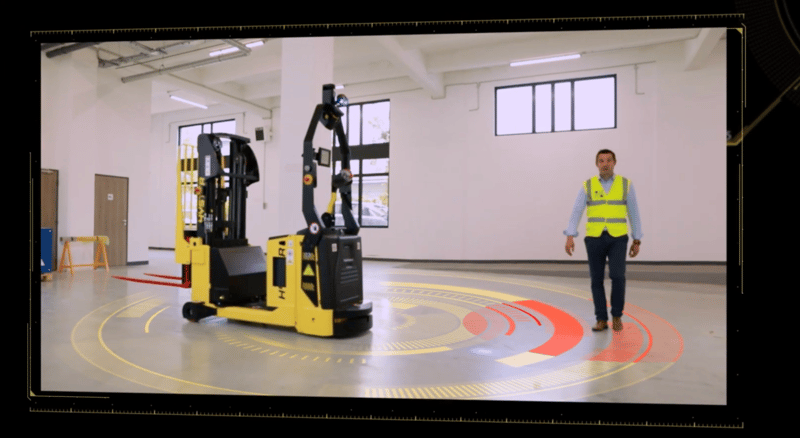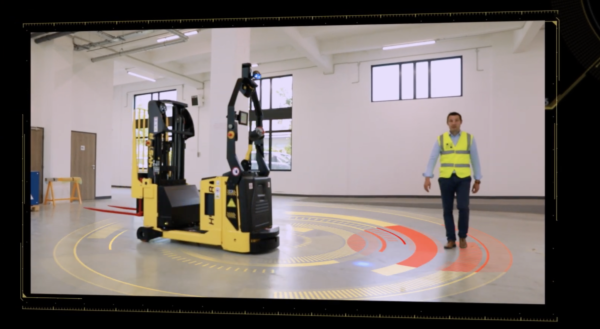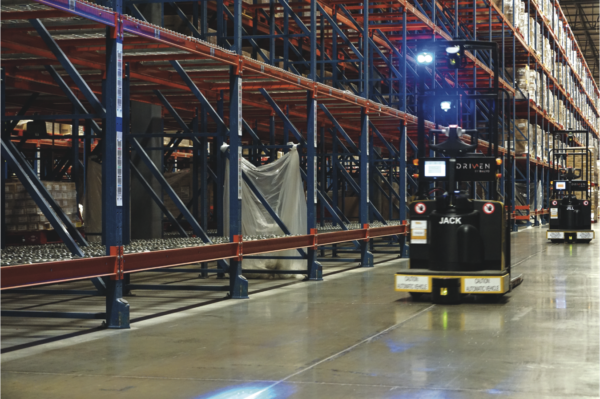
AGVs and Li-ion Batteries. A match made in Heaven
16600 Aston
Irvine, CA 92606
http://onecharge.biz/
Automation brings unprecedented opportunities for the warehouses to improve operating efficiency and reduce costs. Among other innovations, Automated Guided Vehicles (AGVs) are getting momentum.
An automated guided vehicle (AGV) system is a computer-controlled, wheel-based load carrier (normally battery powered) that runs on the plant or warehouse floor (or if outdoors on a paved area) without the need for an onboard operator or driver (MHI definition). Essentially, it is a mobile robot.

The Pioneer Companies.
To make an AGV you need a truck, a connected computer with sensors, and motive power. Balyo, a manufacturer of the “brains” for AGVs, partnered with Hyster-Yale Group and Linde. At the start of operations 3 years ago Balyo researched available options for motive power for their offering and decided to go with Lithium batteries. Baptiste Mauget, VP Marketing at Balyo, said the key requirement was an automated charging system, so electric power was an obvious choice: “The best energy solution for robots is Lithium batteries. We chose LTO chemistry for its longest cycle life and highest availability”. Baptiste further explains that “availability” of AGV in effect means uptime when the vehicle is not paused for charging.
AGVs are sold by the advanced material handling equipment dealers, like Papé. Balyo has supplied a few of its AGVs to Papé’s Demo facility in Seattle, where warehouse managers can see these robots in action. Shane Fairbanks, Manager of the facility: “AGVs are mostly applicable in operations involving “stacker” lift trucks, where you need to pick things from a conveyor and stack them on shelves. Automotive, pharmaceutical, or logistics business are good examples.” Shane said that customers value AGVs because they can run 24/7 without needing an operator. With tangible efficiency improvements, AGVs are starting to get traction with technologically advanced companies with high volumes of material handling and warehouse space. You guessed it right – Amazon. “AGVs in our offer are 100% electric and all of them run on Li-ion,” Shane continues.
OneCharge manufactures Li-ion batteries for material handling industry, with over 550 models for Class I, II and III lift trucks, sweepers, scrubbers, and Ground Support Equipment at airports. OneCharge has supplied Li-ion batteries to Papé’s demo AGV trucks in April 2018, and Shane says that clients’ interests in AGV solutions have started to pick up in the last few months. He calls it the “Amazon Effect on Things”. “Bigger companies may be slow on the adoption, but they have the money to experiment and once they test and prove a solution, others follow in a stream”, Shane says.
Why Lithium Ion?
Facilities that use AGV lead-acid battery-powered fleets consistently face about 20% asset downtime. This is due to the five to six hours of battery charging required for each AGV each day. Additionally, each lead-acid battery is required to be down for another 8 hours weekly for trickle charging and cell equalization.
Indeed, Li-ion batteries’ benefits are even more pronounced with AGVs: significantly less charging time overall and flexible charging schedule, zero daily maintenance and stable voltage with higher travel and lifting speeds provide minimum downtime and highest operational efficiency. In the case with OneCharge Batteries, one can expect enhanced safety and advanced data capabilities with the top-notch Battery Management System and one can’t fail to recognize that AGVs and Li-ion is a perfect match!
 Spirit AeroSystems is one of the world’s leading designers and manufacturers of aerostructures, which provides products and solutions for both commercial and defense customers, including Airbus and Boeing. In late 2018 Spirit AeroSystems has started a demo project to stress-test one AGV Li-ion Battery, which was recommended to them by Green Energy Concept, Inc., consultant and installer of motive power solutions. After 9 months the whole fleet of the company’s lift trucks in Kinston, NC is switching to OneCharge Li-ion Batteries.
Spirit AeroSystems is one of the world’s leading designers and manufacturers of aerostructures, which provides products and solutions for both commercial and defense customers, including Airbus and Boeing. In late 2018 Spirit AeroSystems has started a demo project to stress-test one AGV Li-ion Battery, which was recommended to them by Green Energy Concept, Inc., consultant and installer of motive power solutions. After 9 months the whole fleet of the company’s lift trucks in Kinston, NC is switching to OneCharge Li-ion Batteries.
Most of Spirit AeroSystems NC facility lift trucks are AGVs and MGVs (manually guided by an operator with a remote control). The company was permanently facing problems with maintenance and overall reduced runtime with the sealed lead-acid / TPPL batteries they were using for the last 5 years. The main reasons for switching to Li-ion were increased operational demands which the old lead-acid batteries could not support any longer.
Allen Grady, Equipment Maintenance Manager at Spirit AeroSystems: ”We have a large facility to manufacture parts for AirBus A350, and we use lift trucks to move around big tools 24 hours a day. We had to stack spare lead-acid batteries at a special section of our facility and install special ventilation and other safety features there. Each truck was down for at least 30-40 minutes 6 times a day (twice per shift) changing big and heavy batteries. Big hassle and a big loss of time! With the new Li-ion technology we managed to sync our production schedule with batteries charging. It is now only once or twice per day, the battery stays inside the truck, and it takes 1-1,5 hour to fully charge a battery.”
Oliver Kuarsingh, Director at GECI said: “OneCharge batteries can stand much more abuse and need much less attention compared to lead-acid batteries. ROI calculations and overall stability of OneCharge Li-ion Batteries were the main reasons we recommended OneCharge to Spirit AeroSystems.”
Driving Style: Autonomous Vehicles vs. Humans
How is battery performance is different when used by a human driver compared to the Automated system? In their article in “Electronics & Test,” Sudhi Uppuluri and Doug Kolak are discussing the relative performance of an electric car driven by a human and by an autonomous driver.
It turns out that humans are much less gentle with the motor and battery. What it actually means is that a performance boost for the warehouse with AGVs introduction can be amplified by even higher battery performance and less downtime for charging and maintenance when a truck is controlled by a computer.
Who shall pay attention?
AGVs + Li-ion combination can dramatically improve any warehouse or conveyor operation with the efficiencies and savings mounting with scale.
 We expect the following industries follow the trail blazed by pioneers like Amazon and Spirit AeroSystems: pharmaceuticals, hospital, automotive, aerospace, paper, printing, warehouses & distribution, lumber & furniture, electronics, steel & metal.
We expect the following industries follow the trail blazed by pioneers like Amazon and Spirit AeroSystems: pharmaceuticals, hospital, automotive, aerospace, paper, printing, warehouses & distribution, lumber & furniture, electronics, steel & metal.
Food and beverage processing and distributing should also lead the way for safety reasons (both lead and acid fumes are no toy in the same warehouse with food). In cooler and freezer environment the FROST options of Li-ion batteries are indispensable.
Today there are a few types of battery technologies used in AGVs including flooded lead-acid and TPPL, NiCad, Fuel cells, but the experts are unanimous – AGVs and Li-ion batteries are a match made in heaven!









